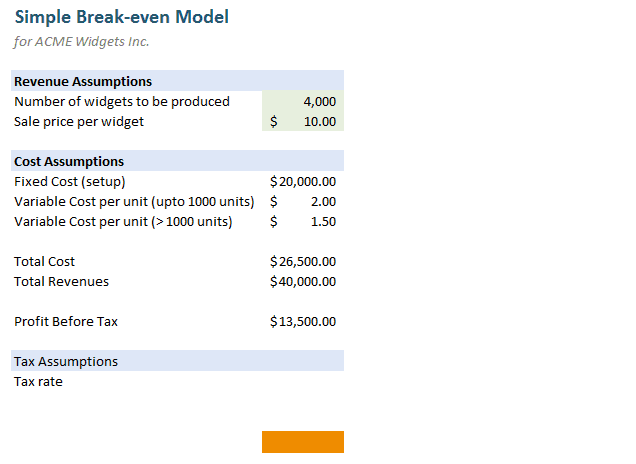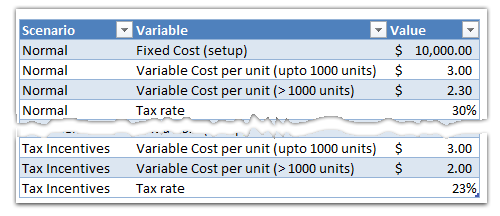Slicers are my new favorite feature in Excel. Introduced in Excel 2010, Slicers are like visual filters.
A simple example of slicers:
Let us say you have a sales report (pivot) for multiple salespersons. Since you want to show the report by one person at a time, you used report filters in pivot tables to display this. But you find that switching between regions is a pain using the report filter.
Enter slicers.
Now, you can just click the region name to show the report for that region, like this:

Using Slicers to Switch between Scenarios Dynamically:
Now, we can use slicers creatively to make an interactive scenario manager in Excel, some thing like this:

This technique gives the same outcome as the Display and Select Scenarios using VBA article, but easier to implement
How to use slicers to switch between scenarios?
Step 1: Set up various scenarios in a table
You need to define various scenarios in a table, like this:

Step 2: Create a pivot table from your scenario data
Select the table you created in step 1 and insert a pivot table. Use variable name as row label and variable value in value field area.
Step 3: Insert a slicer for the scenarios
Select anywhere inside the pivot. Now, from options tab, click on Insert Slicer button. Click on Scenarios field to insert a slicer.

Step 4: Create your model, in our case a break-even model
I will skip the explanation of model creation as that is not relevant here.
Once the model is set up, just refer to the pivot table for each of the variable values.
Step 5: Move slicer to Model
Go to the pivot table worksheet and Select the slicer, click CTRL+X to cut it.
Go back to your model worksheet and paste the slicer.

Step 6: Format the slicer
Excel slicers by default show an option to remove the filtered slicer. You can get rid of this button by,
1) Right click on the slicer
2) Go to slicer settings
3) Un-check Display Header option
See aside.
Step 7: Use the slicer to interactively switch scenarios
That is all, our smart scenario switching slicer is ready. Now, you can extend this in many ways. For example, you can write some clever formulas to handle selection of multiple slicers. You can compare between one scenario and another when more than one option is chosen from the slicer. So much more is possible. But I will let your imagination run wild.
Download Example Excel File:
I have made a simple example to demonstrate this technique.
Please download the file and open it in Excel 2010.
Examine the worksheets “Scenario Pivot” and “Model” to understand how the slicer is setup and how this works.
Do you slice?
As I said, Slicers are my new favorite feature in Excel. I have been using them as much as possible because they are simple to use and very powerful.
What about you? Do you slice often? What is your experience like? Please share your ideas and tips using comments.
More examples on Slicers & Pivot Tables:
1) Creating a Dynamic Dashboard in Excel using Slicers
2) Creating a Dynamic Chart using Pivot Table Report Filters
3) Remove Duplicates and Sort a list using Pivot Tables
4) More on Pivot Tables & Modeling


















15 Responses to “Christmas Gift List – Set your budget and track gifts using Excel”
[...] Christmas Gift List – Set your budget and track gifts using Excel … [...]
I'm confused: if you spend $10, and your budget is $40, shouldn't the amount in the "Within Budget?" column stay black, since you didn't go over budget?
In other words, since we overspent on the electronic photo frame, shouldn't the $8 cell turn red?
@JP.. maybe Steven is encouraging consumerism... ?
I havent realized it earlier, but now I see it. If you unprotect the sheet, you can change the formula in Column I to =IF(G13=0;" ";F13-G13) from =IF(G13=0;" ";G13-F13), that should correct the behavior.
Thanks Chandoo. I thought of making a shopping list spreadsheet for Christmas, but this is neat so I think I'll use this instead.
Chandoo & Steven thanks for this spreadsheet. But for the sake of a person who has been staring at this megaformula in vain for the last 40 mins and not afraid to ask, would it be possible for you to walk us through the logic used here?
=SUM(SUMPRODUCT(SUBTOTAL(3,OFFSET($K$13:$K$62,ROW($K$13:$K$62)-MIN(ROW($K$13:$K$62)),0,1)),--($K$13:$K$62="-"))+SUMPRODUCT(SUBTOTAL(3,OFFSET($K$13:$K$62,ROW($K$13:$K$62)-MIN(ROW($K$13:$K$62)),0,1)),--($K$13:$K$62="0")))&" / "&SUBTOTAL(2,$G$13:$G$62)
Thanks Chandoo.. This is one of the best budget spreadsheets I've ever seen.. The Arrays are out of this world!! And it's FREE!!
Chandoo, can you tell us more about Steven? Does he have his own site?
JP, I think Chandoo changed it when he changed the currency formatting from £ to $, a negative figure is a good thing in this case. But don't change the formulas, the overbudget and under budget won't work properly if you do. Also Chandoo I think you've accidentally broke the conditional formatting for the alternating row colouring the formula is different to the version I sent you. As for the megaformula chrisham, it gave me a headache trying to get it all working, so I will let Chandoo talk you through it.
Hi,
In cells I6 and I7, I understand that subtotal together with offset function returns an array of ones after which, the sumproduct function gives the desired result.
But I’m not able to figure out the reason for using an array in I8 to return the most expensive gift.
Can’t the formula be just
“=VLOOKUP(SUBTOTAL(4,$G$13:$G$62),$G$13:$J$62,4,0)”
Savithri, Cell I8 needs the array, if the formula was “=VLOOKUP(SUBTOTAL(4,$G$13:$G$62),$G$13:$J$62,4,0)” it would find the highest price from the filtered range (i.e. highest actual in filtered range is $50) BUT then return the first person with that actual, not looking in just the filtered range (so first person on the list with a $50 actual.)
To see what I mean, change the formula, then change all the actuals to $50 then filter for baby, it lists the first name on the list.
But a good question 🙂
Thank you. I now realise that the array is used to get the ‘filtered range’ instead of the entire range, as table array for look up value.
[...] Download This Template [...]
this looks like an awesome excel sheet!! is there anyway i can get it emailed to me unprotected? for some reason, i am unable to download it 🙁 help!!
Hi I also can not download to a mac as the sheet is protected any help would be great
[...] to send her a pricey present. Rather, send a card with a picture of your child. Here’s a cool Excel sheet that will help you estimate your budget per person and let you track [...]
[...] husband and I pour/poor over the Christmas spreadsheet (yes, I do know how dorky that sounds, but we’re not the only ones!), figuring out who should give what to whom. We live at a distance from most of our family, so it [...]